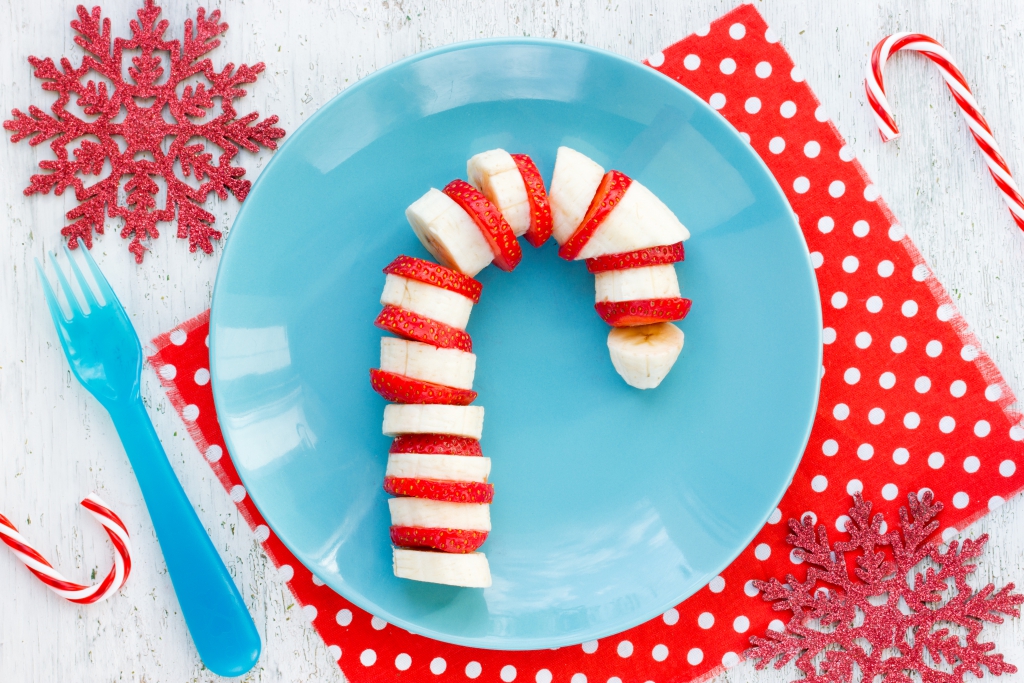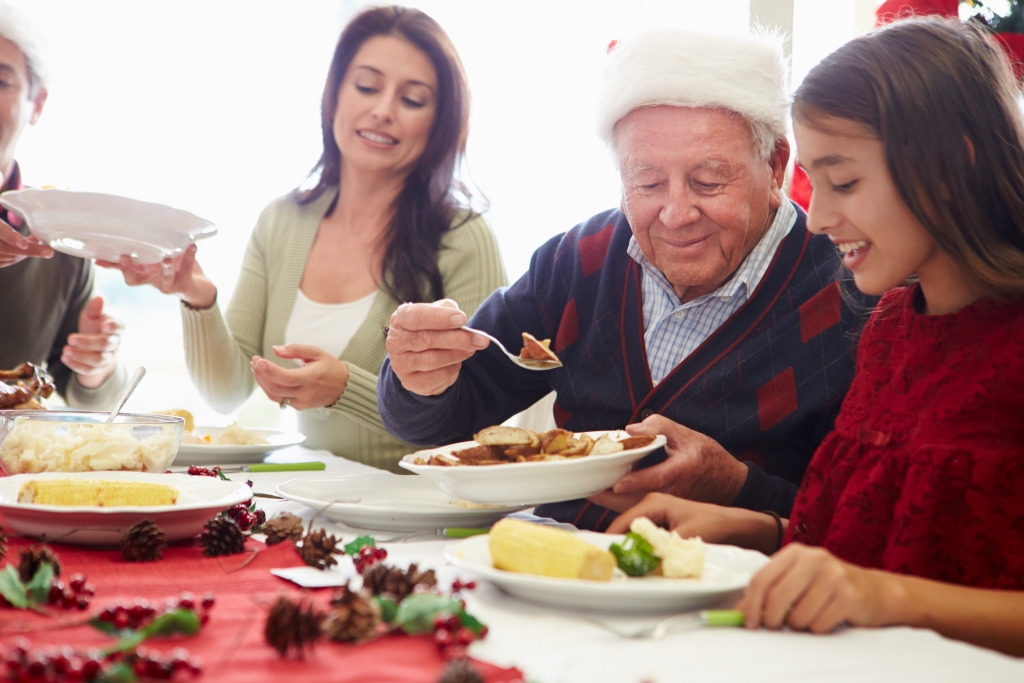
With the winter holidays in full swing, Nebraska researchers offered their top tips for navigating the season with good cheer. This special miniseries provides research-based recommendations on designing energy-efficient light displays; accommodating food allergies; adding healthy choices to the holiday buffet; recycling holiday decor; and decreasing stress to maximize the enjoyment of the season.

Tracking calories in real time may curb overindulgence
During the holiday season, an average adult gains about a pound – which is often never lost. This trend may contribute to the U.S.’s increasing rates of obesity, cardiovascular disease, diabetes and other long-term illnesses.
Nebraska agricultural economist Christopher Gustafson is working to help people make healthier decisions about food consumption. In a 2019 study, Gustafson explored whether access to a real-time calorie counter would spur healthier choices.
Compared to people without a calorie tracker, the participants who used the device had a more accurate view of the number of calories they selected over five sequential food choices. They also chose significantly fewer calories overall. The differences occurred in the last few selections, suggesting that people without a tracker overindulged down the line because they underestimated the caloric value of earlier choices.
This means people may make poorer choices at a later point in time – at dessert or during a second trip through the buffet line, for example – because they’ve undershot their caloric intake to that point.
Until free, real-time calorie trackers are available – a long-range goal of Gustafson’s research – people can help themselves by staying attuned to their actual consumption.
“At a time of year full of holiday celebrations – usually with tempting foods – people may be able to make their New Year’s resolutions easier to accomplish by trying to be honest with themselves about the foods they’re consuming now,” Gustafson said.

Boosting your home’s cheer, but not your energy bill
Holiday lights are beautiful, but they also sap power. Estimates from the Department of Energy indicate Americans’ holiday light use burns 6.6 billion kilowatt-hours annually – enough to fuel more than 800,000 homes for a year.
Luckily there are ways to mitigate power use without turning into the Grinch, said Jerry Hudgins, interim director of the Nebraska Center for Energy Sciences Research and professor and chair of electrical and computer engineering.
Using LED lights rather than traditional incandescent bulbs yields significant savings, he said. They’re more expensive up front, with an LED bulb costing about $1.50 compared to 25 cents for a same-sized regular bulb. But over time, the investment pays off: LEDs use up to 70% less energy than traditional lights, and they last roughly 10 times longer.
“Because of the lower electrical power requirements, LEDs cause fewer greenhouse gases to be emitted from electric power generation, and so are more environmentally friendly,” Hudgins said.
Another power-saving tip is to put your outdoor lights on a timer, so that they’re running during high-traffic times, when the greatest number of people will enjoy them. Hudgins pointed out that after midnight, few people are out and about to admire your display.
Beyond energy-saving tips, Hudgins recommends that people stay safe with outdoor holiday displays by using extension cords that are rated for outdoor use and have the proper gauge wire size. A lower number, or gauge, corresponds to a larger diameter wire and can handle a higher electrical load.
“A long extension cord with small gauge wire can overheat if the electrical load is too high,” Hudgins said.

Helping yourself – and your dog – stay calm
Depleted bank accounts, time with the family and an onslaught of parties and events is enough to bring on the holiday frazzle for many people.
One solution? Jeffrey Stevens, associate professor of psychology and director of Nebraska’s Canine Cognition and Human Interaction Lab, said turning to your four-legged companion for support is a scientifically backed way to ratchet down the pressure.
“Our research has shown that briefly petting a dog can improve mood and reduce stress and anxiety,” Stevens said. “So if things get a little overwhelming, spend some quality time with your pet to calm yourself and strengthen your bond.”
Remember, though, the holidays aren’t just stressful for people – dogs can get keyed up too, with extra UPS deliveries, guests in the house and packages on the floor to explore. Stevens said to watch out for dogs’ signs of stress – panting, yawning and lip licking in situations where those behaviors don’t typically occur.
“If it seems like your pet is stressed, make sure they have a quiet place to relax away from the hustle and bustle.”
Stevens launched the Canine Cognition and Human Interaction Lab in 2018, aiming to develop a better understanding of dog psychology and how interacting with dogs influences human behavior and psychology.

Enhancing children’s nutrition during the holidays
‘Tis the season for cookies, candy and sweets – but it’s also possible for families to celebrate the holidays healthfully by incorporating fruits and vegetables.
“You can make healthy foods festive by getting creative with fruits and vegetables to make fun snacks that are bright and delightful,” said Carly Hillburn, a Nebraska dietetics intern and collaborator on the Ecological Approach to Family Style dining program.
Examples include making “Grinch Santas” by stacking green grapes, banana slices and strawberries, or placing sliced strawberries and bananas into a candy cane shape.
The EAT Family Style team also recommends:
- Getting children involved at mealtimes to pique their interest in trying their creations: For example, toddlers can dump ingredients into bowls and stir; preschoolers can use cookie cutters and rinse produce; and elementary-aged children can crack eggs and use vegetable peelers.
- Exploring healthy meals by engaging children’s senses and talking about nutritional benefits: Since children are curious about the world, ask them to explore their food using the five senses. You can ask specific questions about foods, such as “Did you hear the celery crunch when you took a bite?” or incorporate nutritional phrases into mealtimes, such as “Fruits will give my body energy.”
EAT Family Style is led by Dipti Dev, the Betti and Richard Robinson Associate Professor of Child, Youth and Family Studies. Saima Hasnin, doctoral student in child, youth and family studies, and Rachel Maloy, an undergraduate in nutrition and dietetics, contributed to this article.

Building happier, healthier families through storytelling
The holiday season is replete with family time and intergenerational gatherings.
Nebraska’s Jody Koenig Kellas, professor of communication studies and an expert on interpersonal, family and health communication, said the family stories we hear and tell can have a significant and lasting impact on family members. For this reason, the holidays can be the perfect time to intentionally engage in storytelling in order to learn about or revisit family history and create stronger ties.
Koenig Kellas said family stories help create a sense of family identity; socialize members about family meanings, values and beliefs; cope with and make sense of difficulty and stress; and connect with one another.
But her research shows that how families share stories is crucial.
“Families who engage in storytelling by being present and warm, who share the floor and build on each other’s contributions, who seek out and honor each other’s perspectives on how things happened or the meaning of the story, and who work together to create the meaning or moral of the story – these families report higher levels of health and happiness than families who are distant, disengaged, don’t take each other’s perspectives into account and don’t work together to build story meaning,” Koenig Kellas said.
In short, being mindfully engaged, other-centered and collaborative during the storytelling process is one avenue for promoting family satisfaction and closeness.

Giving your Christmas tree a second life
During the holiday season, decor often includes a fresh-cut Christmas tree. But after the ornaments and lights are back in storage, most real trees end up in landfills, where they can take years to break down.
But there are other options for your evergreen, according to Nebraska Extension horticulture educators Nicole Stoner and Sarah Browning.
Here are their tips:
- Create a backyard habitat to feed the birds: After stripping the tree of decor, move it to the south or east side of your home, anchor it securely and decorate it with strings of popcorn, cranberries or raisins to create a bird oasis.
- Boost local fish habitat: If you take your tree to a local lake designated for Christmas tree recycling, it will be placed on the lake’s ice in the winter. When the ice melts in spring, the trees fall into the water and function as fish habitat.
- Sustain local parks: Lincoln has several recycling points for Christmas trees, which are collected, chipped and used as mulch or pathway cover in city parks and arboreta.
- Beautify your garden: Chip your tree and use it as garden mulch in the spring. Alternatively, clean up the tree and use it to make a trellis, which can be used to grow cucumbers up off the ground.

Staying merry despite food allergies
Many people love to indulge in the traditional dishes and flavors of the holiday season. But for individuals and families with food allergies, these food-filled events can become dangerous.
“Food allergies are potentially life-threatening conditions affecting millions of Americans, and the only way to prevent reactions is strict avoidance,” said Melanie Downs, assistant professor of food science and technology and a member of Nebraska’s Food Allergy Research and Resource Program. “Even very small amounts of food can cause reactions.”
But Downs and Eleanor Garrow-Holding of the Food Allergy & Anaphylaxis Connection Team, a FARRP collaborator, said food allergies are manageable, even during the holidays. Here are their tips for event attendees:
- Contact your host and alert them of the allergy and precautions, including not having the allergen present, if necessary.
- Offer to go a little early and help clean.
- Offer to help the host cook the food.
- Have your child eat a snack before you go, so they’re less tempted to grab food when you’re not watching.
- Bring separate dishes that you know your child can eat.
- Remind your child about not eating anything that you haven’t OK’d first.
- Always be prepared with an allergy and anaphylaxis emergency care plan and epinephrine, if prescribed.
More information is available on the FARRP and FAACT websites.

Combating holiday blues in children
The wintertime hustle and bustle is overwhelming to some children, particularly those who have experienced a significant change in their life.
Nebraska Extension’s Lisa Poppe, who specializes in the social and emotional well-being of children, said holiday plans that are typically happy and exciting can be complicated by divorce, separation, remarriage or the loss of a parent or other important figure.
“When children are in these situations, the holidays may remind them of how their life was before, and the emotional conflict and stress can ruin their time,” said Poppe, who is part of the Metro Extension District.
Poppe provided the following tips to help children navigate the stress:
- Maintain family traditions even if a parent is absent. Children look forward to the normalcy of these traditions and feel safe in this routine.
- It’s OK if you don’t see everyone or do everything. Overscheduled children become burned out, overtired and cranky.
- Make sure children get plenty of sleep.
- Build in extra time for traveling, and bring plenty of snacks, games and books with you.
- Don’t forget to take care of yourself. When you’re overcommitted or on edge, children feel that stress.





